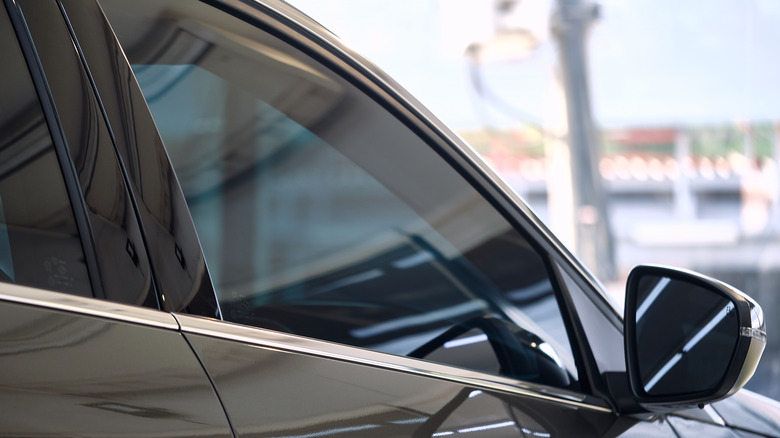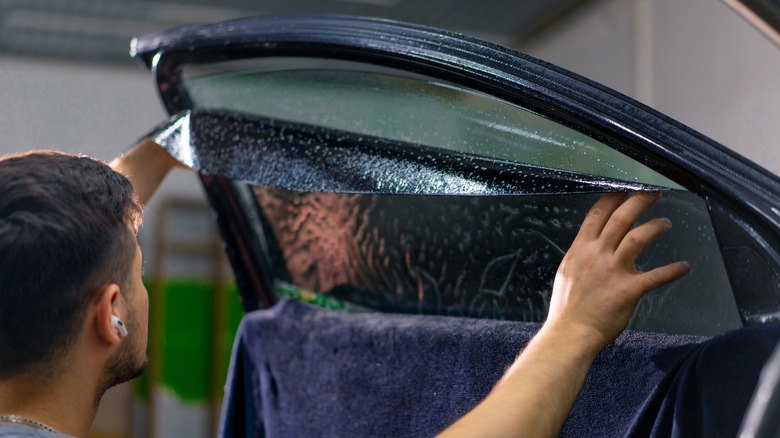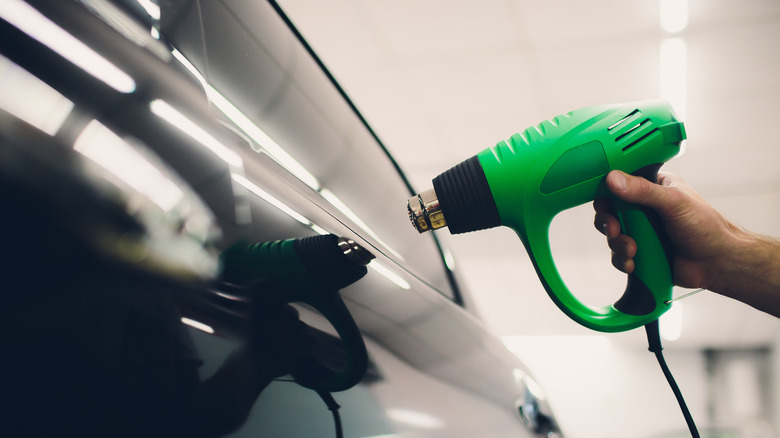Ceramic Vs. Carbon Window Tint: What's The Difference, And Is Ceramic Really Worth It?
There is no shortage of ways to keep your car cool as we enter the increasingly sweltering temperatures of the coming months. Among the simplest things you can do is tinting your windows. Adding a layer of this dark laminate film to your car's windows is the best way to ensure the inside of your vehicle's interior is protected from excessive heat and sunlight, while giving you an added level of privacy. Some window tints are even strong enough to protect against harmful UV rays and prolong your car's interior from fading.
But window tints are not all made the same. Just like the cars that they cover, window tints are made out of a wide range of materials including metallic, dyed, and hybrid variations. But the two that are most commonly pitted against one another as to which is better are carbon and ceramic window tints. Like all other window tint varieties, carbon and ceramic have their own benefits and drawbacks, but in many cases, ceramic is largely favored by experts. Is all the hype about ceramic really worth it?
Picking which one is best for you entirely depends on your needs and preferences, so it's a good idea to learn about each type to make a more informed decision. Here's what to know about ceramic and carbon window tints and if ceramic is truly as good as some say.
What to know about ceramic tint
Ceramic window tinting is a highly recommended option to protect you and the inside of your car. What sets this variety of tint apart from all the rest is that the ceramic particles that make it up are non-conductive and non-metallic, while also not containing any additional dyes or carbon. Off the bat, it's worth noting that this unique construction is responsible for this tint's biggest drawback, that being its high price point. Whether having the tint applied professionally or doing it yourself, you'll typically find that ceramic tint is over $100 more than carbon or similar tint types.
With that being said, the high quality of ceramic window tint more than justifies its cost. Along with providing excellent heat reduction by blocking infrared light, the tint's unique construction gives it unparalleled UV ray protection capabilities, with some experts noting stating that ceramic can block upwards of 99.9% of UV rays. Excessive, unprotected exposure to these rays can lead to numerous health issues, potentially including skin cancer.
On top of this, ceramic is also far easier to see through than other darker tints while still offering sufficient privacy, making it a great choice for nighttime drivers. As a result, ceramic tint, despite its excessive price, is a great investment for the long-term health of you and your vehicle's interior.
What to know about carbon tint
Carbon window tint represents a significant upgrade from metallic or dyed tints. Unlike these varieties, you won't have to worry about your phone or GPS signal being blocked. At the same time, it's a particularly great option for those seeking a little extra privacy while in driving.
Being composed of carbon particles gives this tint a non-reflective surface that's hard to see through and provides a sleek aesthetic to your car. That same surface is also especially efficient at repelling light and heat, while also reducing the sun's glare. It is also a far cheaper option than ceramic, often costing between $100 and $250 depending on the scope of the tint.
However, keep in mind that especially dark-tinted windows are considered illegal in numerous states, so ensure that whatever tint you choose complies with your local laws. Also, despite being so good at reducing sunlight, carbon isn't as effective at protecting you from the sun's UV rays. Nevertheless, its economical and privacy qualities still make it a suitable choice for most drivers, so long as they're aware of its limitations.
Is ceramic truly the better option?
So who comes out on top of the window tint wars? While both ceramic and carbon have their pros and cons, at the end of the day, it's hard to call ceramic anything less than the superior tint. According to Consumer Reports auto technician Mike Crossen, ceramic offers an overall better blend of benefits when compared to traditional tints, stating, "It's going to block a higher percentage of UV light, which will keep the car cooler and slow the fading of your car's interior. It also adds protection from the sun's rays without the need for a darker tint. You can have a lighter tint that still offers superior protection."
But does that make carbon a poor pick? Of course not. Even if lacking the visibility and advanced UV protection that comes with ceramic, carbon still stands above most other tint varieties thanks to its durability, heat reduction, and cost. If you're looking for a more cost-effective option that still performs well, carbon remains a stellar choice, especially if you're not a frequent driver or drive at night. But for those able to invest, ceramic tint delivers unmatched performance and protection for the long road ahead.



